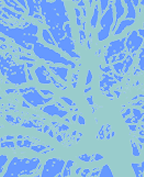|
About
back
|
Written for
presentation at the opening performance of Partial
Perceptions at the Whitney Museum
of American Art’s Performance on 42nd series Performing
Bodies and Smart Machines, March 13,
1992.
PARTIAL PERCEPTIONS
Introductory Notes
A few words about my performance, and the interests and ideas that have
helped shape it.
First, a word about myself. I'm a sound composer, but my background
is not in music. It's in literature. I was a comic fiction writer for
25 years. When I began the switch to sound, it was with the idea of
recomposing my written work for radio. In the years that followed, radio
became my training ground, the place where I shaped my particular kind
of composition, by trying to come to grips with the medium as an artistic
context.
Two things have had a particular influence on me: first, the sound—
gathering techniques of radio and the materials they make available
to me; and second, the space: the invisible, immaterial space which
is the space of radio.
Sound Gathering
Early in this century, technology gave us those now familiar tools—
the microphone, tape recorder, and magnetic tape. With them it became
possible, for the first time in history, to separate sound from its
source—to take speech away from the speaker, for instance, and
store it. To carry it wherever you want, whenever you want. And with
certain tools (razor blade, mixer, now computer) to cut it, mix it,
put it together with other scraps of linguistic, musical, or ambient
material. To manipulate and transform it into something it was not.
To alter its function, to create a new context, another purpose.
What this means to someone like myself is first, that all sounds are
available to me. And second, that because these sounds are stored on
tape and are just that: sounds—not people or animals or locations—there
can be equity in their use. No one kind of sound need be prioritized
over another. The human voice need not be prioritized over other voices;
music over other forms of sound composition. And third, that the whole
process invites rearrangements—the shaping of new associations,
new networks of connection.
Taken seriously, it is a liberation from traditional sound practice.
What I can build with the materials at my disposal need not replicate
the structures or notions that have defined sound composition in the
past. They need not replicate any of the existing dominations. With
recording technology, we can craft new associations, imagine possible
unities, forge partial connections— without challenging the validity
of other associations, unities, or connections.
In Partial Perceptions,
and largely because of this Whitney space and its particular acoustic
properties, I make use of only a few sound sources: Shelley Hirsch's
voice, instrumental sound created by Joseph Celli, and the voices of
the frogs, birds, and the water of Sterling Pond in upstate New York.
The arrangements and rearrangements of these sounds are designed to
create space.
So, what about space? Let me go back to radio. What is radio space?
And where is it?
Unlike painters, artists working in radio have no walls on which to
hang their art. Unlike musicians, they have no halls with knowable acoustic
properties in which to perform. Radio space is immaterial, invisible;
it has no architecture.
How does one deal with this, and with the fact that radio works are
delivered as sonic waves to thousands of discrete locations: kitchens,
bedrooms, bars, streets, where they enter the ears of many individual,
but usually separate, listeners?
How can one deal with this? the invisibility of performance? the multiplicity
of locations at which one's sound arrives? Well, one of the answers
is certainly: one can explore the dimensions of sonic space and the
possibilities of using sound to create invisible architectures—places
into which all of these innumerable, individual, and separate listeners
can enter, if they want.
The reality of this kind of architecture is not the reality of the embodied
world; it is the reality of fiction. Partial
Perceptions, which is about space as
much as anything else, is made up of a number of such architectures.
In the frog section, I make use of a taped image of reality, but the
space you can enter is not one that exists or has ever existed in the
real world. The frogs activate a wind harp. Shelley Hirsch's voice appears
as the small chirps in the foreground of the environment; Joseph Celli's
English horn (without reeds) is the lonely cry in the distance. This
is a construct not of reality but of the mind. A habitat of my imagination
that I hope will become the habitat of yours.
In bringing it here, into this place, it is also my hope that it will
give you a new experience of the other extraordinary and very real space
which is the Whitney Museum at Philip Morris.
One final word: recently I've made use of a lot of natural sound, and
yes, it is, in some way, an act of preservation. Our natural environment
is no longer that of nature: of birds, bees, and flowers. Our natural
environment is technological: an environment of FAX machines, telephones,
television sets, of machines of varying degrees of intelligence. In
Partial Perceptions
I bring you the older environment, transformed by technology—a
fiction that is reminiscent of what has been, but that has been animated
and made new by the magical possibilities realizable through technology.
Partial Perceptions
is a hybrid in every sense of the word.
(TOP)
|
|

    
|



